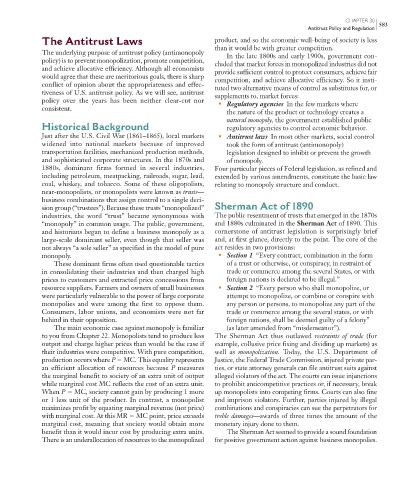Page 674 - Economics
P. 674
CONFIRMING PAGES
CHAPTER 30
583
Antitrust Policy and Regulation
The Antitrust Laws product, and so the economic well-being of society is less
than it would be with greater competition.
The underlying purpose of antitrust policy (antimonopoly In the late 1800s and early 1900s, government con-
policy) is to prevent monopolization, promote competition, cluded that market forces in monopolized industries did not
and achieve allocative efficiency. Although all economists provide sufficient control to protect consumers, achieve fair
would agree that these are meritorious goals, there is sharp competition, and achieve allocative efficiency. So it insti-
conflict of opinion about the appropriateness and effec- tuted two alternative means of control as substitutes for, or
tiveness of U.S. antitrust policy. As we will see, antitrust supplements to, market forces:
policy over the years has been neither clear-cut nor • Regulatory agencies In the few markets where
consistent.
the nature of the product or technology creates a
natural monopoly, the government established public
Historical Background regulatory agencies to control economic behavior.
Just after the U.S. Civil War (1861–1865), local markets • Antitrust laws In most other markets, social control
widened into national markets because of improved took the form of antitrust (antimonopoly)
transportation facilities, mechanized production methods, legislation designed to inhibit or prevent the growth
and sophisticated corporate structures. In the 1870s and of monopoly.
1880s, dominant firms formed in several industries, Four particular pieces of Federal legislation, as refined and
including petroleum, meatpacking, railroads, sugar, lead, extended by various amendments, constitute the basic law
coal, whiskey, and tobacco. Some of these oligopolists, relating to monopoly structure and conduct.
near-monopolists, or monopolists were known as trusts —
business combinations that assign control to a single deci-
sion group (“trustees”). Because these trusts “monopolized” Sherman Act of 1890
industries, the word “trust” became synonymous with The public resentment of trusts that emerged in the 1870s
“monopoly” in common usage. The public, government, and 1880s culminated in the Sherman Act of 1890. This
and historians began to define a business monopoly as a cornerstone of antitrust legislation is surprisingly brief
large-scale dominant seller, even though that seller was and, at first glance, directly to the point. The core of the
not always “a sole seller” as specified in the model of pure act resides in two provisions:
monopoly. • Section 1 “Every contract, combination in the form
These dominant firms often used questionable tactics of a trust or otherwise, or conspiracy, in restraint of
in consolidating their industries and then charged high trade or commerce among the several States, or with
prices to customers and extracted price concessions from foreign nations is declared to be illegal.”
resource suppliers. Farmers and owners of small businesses • Section 2 “Every person who shall monopolize, or
were particularly vulnerable to the power of large corporate attempt to monopolize, or combine or conspire with
monopolies and were among the first to oppose them. any person or persons, to monopolize any part of the
Consumers, labor unions, and economists were not far trade or commerce among the several states, or with
behind in their opposition. foreign nations, shall be deemed guilty of a felony”
The main economic case against monopoly is familiar (as later amended from “misdemeanor”).
to you from Chapter 22. Monopolists tend to produce less The Sherman Act thus outlawed restraints of trade (for
output and charge higher prices than would be the case if example, collusive price fixing and dividing up markets) as
their industries were competitive. With pure competition, well as monopolization. Today, the U.S. Department of
production occurs where P MC. This equality represents Justice, the Federal Trade Commission, injured private par-
an efficient allocation of resources because P measures ties, or state attorney generals can file antitrust suits against
the marginal benefit to society of an extra unit of output alleged violators of the act. The courts can issue injunctions
while marginal cost MC reflects the cost of an extra unit. to prohibit anticompetitive practices or, if necessary, break
When P MC, society cannot gain by producing 1 more up monopolists into competing firms. Courts can also fine
or 1 less unit of the product. In contrast, a monopolist and imprison violators. Further, parties injured by illegal
maximizes profit by equating marginal revenue (not price) combinations and conspiracies can sue the perpetrators for
with marginal cost. At this MR MC point, price exceeds treble damages —awards of three times the amount of the
marginal cost, meaning that society would obtain more monetary injury done to them.
benefit than it would incur cost by producing extra units. The Sherman Act seemed to provide a sound foundation
There is an underallocation of resources to the monopolized for positive government action against business monopolies.
mcc26632_ch30_581-597.indd 583 9/11/06 4:09:06 PM
9/11/06 4:09:06 PM
mcc26632_ch30_581-597.indd 583

